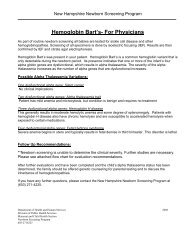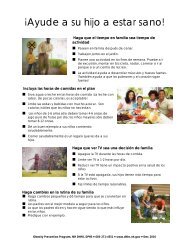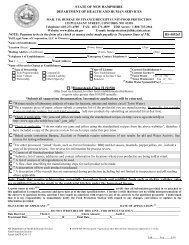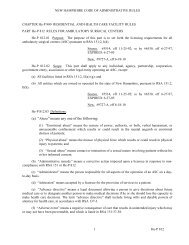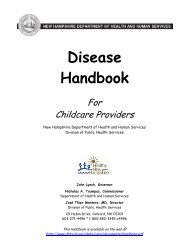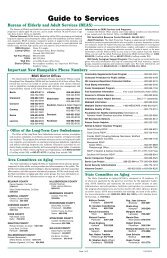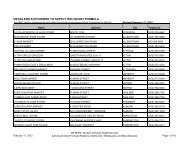Lyme Disease and Other Tick-Borne Diseases - New Hampshire ...
Lyme Disease and Other Tick-Borne Diseases - New Hampshire ...
Lyme Disease and Other Tick-Borne Diseases - New Hampshire ...
You also want an ePaper? Increase the reach of your titles
YUMPU automatically turns print PDFs into web optimized ePapers that Google loves.
<strong>New</strong> <strong>Hampshire</strong> Health Alert Network<br />
Health.Alert@nh.gov<br />
Status:<br />
Message Type:<br />
Severity:<br />
Sensitive:<br />
Message Identifier:<br />
Delivery Time:<br />
Acknowledgement:<br />
Originating Agency:<br />
Actual<br />
Alert<br />
Moderate<br />
Not Sensitive<br />
NH-HAN #20120524 <strong>Lyme</strong> <strong>Disease</strong> <strong>and</strong> <strong>Other</strong> <strong>Tick</strong>-<strong>Borne</strong> <strong>Disease</strong>s<br />
12 hours<br />
No<br />
NH Department of Health <strong>and</strong> Human Services, Division of Public Health Services<br />
DATE: May 24, 2012 TIME: 1200 EDT<br />
TO: Physicians, Physician Assistants, Nurses, Infection Control Practitioners, Infectious<br />
<strong>Disease</strong> Specialists, Hospital Emergency Departments, Hospital CEOs, Laboratory<br />
Response Network, Manchester Health Department, Nashua Health Department, NHHA,<br />
NH School Nurses <strong>and</strong> Administrators, Community Health Centers, EWIDS, DHHS<br />
Outbreak Team, DPHS Investigation Team, Public Health Network Coordinators, <strong>and</strong><br />
DPHS Management Team, Zoonotic Alert Team, Health Officers, Deputy Health<br />
Officers, MRC, NH Schools, EWIDS<br />
FROM: Jodie Dionne-Odom, MD, Deputy State Epidemiologist<br />
SUBJECT: <strong>Lyme</strong> <strong>Disease</strong> <strong>and</strong> <strong>Other</strong> <strong>Tick</strong>-<strong>Borne</strong> <strong>Disease</strong>s<br />
NH Department of Health <strong>and</strong> Human Services (NH DHHS) recommends:<br />
• Awareness that the incidence rate of <strong>Lyme</strong> disease in NH in 2010 was the third highest in<br />
the nation. In most NH counties, over 50% of deer ticks sampled from 2007-2010 were<br />
infected with Borrelia burgdorferi, the bacteria that causes <strong>Lyme</strong> disease.<br />
• Prevention of disease with frequent tick checks after possible outdoors exposure since<br />
removal of a deer tick within 24-36 hours of attachment can prevent disease transmission.<br />
• Recognition that diagnosis of early <strong>Lyme</strong> disease (erythema migrans) should be based<br />
solely on clinical suspicion since diagnostic serologies (including IgM) may not yet be<br />
positive.<br />
• Report all tick-borne diseases, confirmed or suspected, to the Division of Public Health<br />
Services (DPHS) within 72 hours at 603-271-4496 (after hours 1-800-852-3345, x5300).<br />
Background<br />
<strong>Lyme</strong> disease (Borrelia burgdorferi), babesiosis (Babesia microti), <strong>and</strong> anaplasmosis (Anaplasma<br />
phagocytophilum) are transmitted by the bite of the deer tick (Ixodes scapularis), also known as<br />
the black-legged tick. Although ticks have a 2 year life cycle, the greatest risk for human<br />
acquisition of tick borne diseases is between May <strong>and</strong> August when the aggressive nymph stage<br />
of the deer tick is active. Nymphs are very small (< 2mm) <strong>and</strong> easy to miss unless they become<br />
attached <strong>and</strong> engorged with blood.<br />
Epidemiology<br />
Since the peak of 1,598 cases of <strong>Lyme</strong> disease reported in NH in 2008, we have seen a plateau in<br />
the number of reported cases. In 2011, 1,301 cases (confirmed <strong>and</strong> probable) were reported, with<br />
the highest disease rates occurring in Rockingham, Strafford <strong>and</strong> Hillsborough counties,<br />
respectively. Although NH ticks can be coinfected with organisms that also cause babesiosis or<br />
anaplasmosis, these reportable diseases are infrequently diagnosed. In 2011, 30 cases of
NH DHHS-DPHS<br />
NH-HAN #20120524 <strong>Lyme</strong> <strong>Disease</strong> <strong>and</strong> <strong>Other</strong> <strong>Tick</strong>-<strong>Borne</strong> <strong>Disease</strong>s Page 2<br />
anaplasmosis <strong>and</strong> 14 cases of babesiosis were reported. Compared to national data from 2010<br />
(the latest year for which it is available), CDC reports that NH has the third highest incidence rate<br />
of <strong>Lyme</strong> disease in the US (case rate of 63 per 100,000 population). Only Delaware <strong>and</strong><br />
Connecticut have higher rates of reported disease.<br />
<strong>Lyme</strong> disease data <strong>and</strong> maps by county <strong>and</strong> town from 2006-2011 are available at<br />
http://www.dhhs.nh.gov/dphs/cdcs/lyme/publications.htm<br />
The risk of infection for any individual depends on their outdoor activities <strong>and</strong> the abundance of<br />
infected ticks in the area of exposure. Based on tick surveillance performed during 2007-2010,<br />
over 50% of ticks tested in NH counties were infected with the bacteria causing <strong>Lyme</strong> disease<br />
with the exception of slightly lower rates (40%) in Belknap <strong>and</strong> Carroll, <strong>and</strong> very low numbers of<br />
ticks collected in Coos County, precluding data analysis. Rates of tick infection or coinfection<br />
with B. microti <strong>and</strong> A. phagocytophilum are not yet available for these tick batches but will be<br />
tested by the NH Public Health Laboratories once methods have been validated.<br />
Reporting<br />
When filling out the case report form, remember to document the profession of the individual, in<br />
order to help us track possible occupational exposures to tick borne diseases. It is also important<br />
to record the date of symptom onset since we use this information for disease classification. A<br />
link to the report form is below:<br />
http://www.dhhs.nh.gov/dphs/cdcs/documents/lymediseasereport.pdf<br />
Clinical Presentation <strong>and</strong> Treatment<br />
Following any tick bite, there may be local redness or a small papule at the site due to an<br />
inflammatory response to the tick saliva. This reaction is small, lasting only 1-2 days <strong>and</strong> it does<br />
not denote erythema migrans nor warrant treatment. Based on the high prevalence of <strong>Lyme</strong><br />
disease in NH, providers can consider prescribing single dose doxycycline prophylaxis (200 mg<br />
po once) for patients who meet all of the following four criteria (see attached sheet for additional<br />
information about prophylaxis):<br />
1. The attached tick is a black-legged tick (deer tick, Ixodes scapularis). <strong>Tick</strong><br />
identification is most accurately performed by an individual trained in this discipline.<br />
However, black-legged ticks are very common in southeastern <strong>and</strong> central <strong>New</strong><br />
<strong>Hampshire</strong> <strong>and</strong> there are many images available online to help in general identification.<br />
2. The tick has been attached for at least 24-36 hours. This determination is most<br />
reliably made by an entomologist, but simply asking the patient about outdoor activity in<br />
the time before the tick bite was noticed can often lead to an accurate estimate of<br />
attachment time. Unengorged (unfed) black-legged ticks are typically flat. Any<br />
deviation from this “flatness,” which is often accompanied by a change in color from<br />
brick red to a gray or brown, is an indication that the tick has been feeding.<br />
3. Prophylaxis can be started within 72 hours of the time that the tick was removed.<br />
This time limit is suggested because of an absence of data on the efficacy of prophylaxis<br />
for tick bites following longer time intervals after tick removal.<br />
4. Doxycycline treatment is not contraindicated. Doxycycline is contraindicated in<br />
pregnant women <strong>and</strong> children less than 8 years old. The other common antibiotic<br />
treatment for <strong>Lyme</strong> disease, amoxicillin, should NOT be used for prophylaxis because of
NH DHHS-DPHS<br />
NH-HAN #20120524 <strong>Lyme</strong> <strong>Disease</strong> <strong>and</strong> <strong>Other</strong> <strong>Tick</strong>-<strong>Borne</strong> <strong>Disease</strong>s Page 3<br />
an absence of data on an effective short-course regimen for prophylaxis <strong>and</strong> the likely<br />
need for a multiday regimen <strong>and</strong> its associated adverse effects.<br />
A single dose of doxycycline (200 mg) may be offered to adult patients <strong>and</strong> to children >8 years<br />
of age (4 mg/kg up to a maximum dose of 200 mg). Note that single-dose doxycycline is not<br />
100% effective for prevention of <strong>Lyme</strong> disease; consequently, patients who receive this therapy<br />
should monitor themselves for the development of <strong>Lyme</strong> disease as well as other tick-borne<br />
diseases including anaplasmosis <strong>and</strong> babesiosis. It is also a reasonable course of action to ask the<br />
patient to monitor the bite site <strong>and</strong> call back for further medical evaluation if a rash develops or<br />
any systemic symptoms (see attached form with treatment guidelines). <strong>Tick</strong> testing for tick borne<br />
infectious agents is available in certain labs but is not recommended for guiding individual<br />
prophylaxis or treatment decisions.<br />
A) <strong>Lyme</strong> <strong>Disease</strong> is caused by the bacteria Borrelia burgdorferi <strong>and</strong> the incubation<br />
period is 3-30 days after tick exposure. In approximately 60-80% of patients, illness first<br />
manifests with a red rash that exp<strong>and</strong>s slowly, often with central clearing (erythema<br />
migrans (EM) or bulls eye rash). Early systemic manifestations may include malaise,<br />
fever, headache, stiff neck, muscle <strong>and</strong> joint pains, <strong>and</strong> lymphadenopathy. At this stage<br />
serologic testing is often negative <strong>and</strong> treatment should be based on clinical diagnosis <strong>and</strong><br />
would generally lead to full <strong>and</strong> rapid recovery. Individuals who are not treated at this<br />
stage of infection may develop a variety of symptoms over days to weeks including<br />
aseptic meningitis, cranial neuritis, <strong>and</strong> cardiac abnormalities such as heart block or<br />
myopericarditis. Weeks to years after onset, a patient may develop chronic or intermittent<br />
episodes of arthritis or neurological symptoms.<br />
Within 4 weeks of disease transmission the production of specific antibodies is high<br />
enough to be detected <strong>and</strong> the clinical diagnosis should be supported by two-stage<br />
serologic testing using FDA approved methods. ELISA is the screening test, confirmed<br />
by Western Blot if positive. A patient is considered to have positive <strong>Lyme</strong> serology if 2<br />
of 3 IgM b<strong>and</strong>s are reactive (24, 39, 41 kDa) OR if 5 of 10 IgG b<strong>and</strong>s are reactive (18,<br />
21, 28, 30, 39, 41, 45, 58, 66, 93 kDa). An isolated positive IgM (without positive IgG)<br />
in a patient with a known tick exposure more than 8 weeks prior is suspicious for a<br />
possible false positive test. The diagnosis of <strong>Lyme</strong> disease is based on appropriate<br />
clinical presentation <strong>and</strong> possibility of exposure to the tick vector. Laboratory testing<br />
should be used to support clinical suspicion of disease <strong>and</strong> case definitions used for<br />
public health surveillance are not intended to replace the need for clinical decision<br />
making on an individual basis. Only laboratories with validated <strong>and</strong> approved testing<br />
methods for <strong>Lyme</strong> ELISA <strong>and</strong> confirmatory Western blot should be used for diagnosis of<br />
disease.<br />
The Infectious <strong>Disease</strong> Society of America (IDSA) updated guidelines for tick-borne<br />
diseases in 2006. These were confirmed by an independent panel, with recommendations<br />
published in 2010. A summary of treatment recommendations based on these guidelines<br />
is attached <strong>and</strong> the link is below:<br />
http://cid.oxfordjournals.org/content/43/9/1089.full.pdf+html<br />
B) Anaplasmosis [Human granulocytic anaplasmosis (HGA), previously human<br />
granulocytic ehrlichiosis] is an infection of neutrophils caused by the rickettsial bacteria<br />
Anaplasma phagocytophilum. Clinical manifestations are nonspecific <strong>and</strong> may include<br />
fever, chills, headache, <strong>and</strong> myalgia. Some people, particularly elderly persons or those<br />
with weakened immune systems, may have a more severe illness. Symptoms typically
NH DHHS-DPHS<br />
NH-HAN #20120524 <strong>Lyme</strong> <strong>Disease</strong> <strong>and</strong> <strong>Other</strong> <strong>Tick</strong>-<strong>Borne</strong> <strong>Disease</strong>s Page 4<br />
occur 5-21 days following the bite of an infected tick. People can be successfully treated<br />
with a course of doxycycline which is first line therapy for anaplasmosis. (See attached<br />
treatment guideline table).<br />
C) Babesiosis is caused by the intraerythrocytic protozoa Babesia microti. Although<br />
most people infected with Babesia are asymptomatic, some people experience a viral<br />
infection–like illness with fever, chills, sweats, myalgia, arthralgias, anorexia, nausea,<br />
vomiting, or fatigue. Severe <strong>and</strong> fatal cases most often occur in patients who are older or<br />
have a weakened immune system, particularly those without a spleen. Symptoms<br />
typically occur within one to four weeks following the bite of an infected tick <strong>and</strong> there is<br />
not thought to be a chronic phase of illness (although rare cases of relapsing disease have<br />
been reported). Babesiosis can be successfully treated with antimicrobial therapy (see<br />
attached treatment guideline table).<br />
Prevention: Educate Your Patients<br />
‣ Avoid tick-infested areas when possible. Staying on the path is safer than hiking in the<br />
brush.<br />
‣ Wear light-colored clothing that covers arms <strong>and</strong> legs so ticks can be more easily seen.<br />
‣ Tuck pants into socks before going into wooded or grassy areas.<br />
‣ Apply tick repellent (20% DEET) to exposed skin.<br />
‣ Outdoor workers in NH are at particular risk of tick borne diseases <strong>and</strong> they should be<br />
reminded about methods of prevention.<br />
‣ After time spent outdoors search the body for ticks, especially warm places like the<br />
behind the knees, the groin <strong>and</strong> the back <strong>and</strong> neck (this may require some help).<br />
‣ Remove ticks promptly. (<strong>Tick</strong> removal within 24-36 hours of attachment can prevent<br />
disease).<br />
‣ Monitor for signs <strong>and</strong> symptoms of tick-borne diseases for 30 days after the tick bite <strong>and</strong><br />
patients should call their provider if these develop.<br />
For any questions regarding the contents of this message, please contact<br />
NH DHHS Bureau of Infectious <strong>Disease</strong> Control at 603-271-4496.<br />
For after hours / toll free, call 1-800-852-3345, ext. 4496.<br />
Attachments: 1. <strong>Tick</strong>-borne diseases treatment table<br />
2. <strong>Lyme</strong> prophylaxis guidelines
NH DHHS-DPHS<br />
NH-HAN #20120524 <strong>Lyme</strong> <strong>Disease</strong> <strong>and</strong> <strong>Other</strong> <strong>Tick</strong>-<strong>Borne</strong> <strong>Disease</strong>s Page 5<br />
DEFINITION OF TERMS AND ALERTING VOCABULARY<br />
Message Type<br />
Status<br />
Severity<br />
Sensitive<br />
Alert: Original alert<br />
Update: Prior alert has been updated <strong>and</strong> superseded<br />
Cancel: Prior alert has been cancelled<br />
Error: Prior alert has been retracted<br />
Actual: Refers to a live event<br />
Exercise: Designated recipients must respond to the communication or alert<br />
Test: Related to a technical <strong>and</strong>/or system test<br />
Extreme: Extraordinary threat to life or property<br />
Severe: Significant threat to life or property<br />
Moderate: Possible threat to life or property<br />
Minor: Minimal threat to life or property<br />
Unknown: Unknown threat to life or property<br />
Sensitive: Indicates the alert contains sensitive content<br />
Not Sensitive: Indicates non-sensitive content<br />
Message Identifier<br />
Delivery Time<br />
Acknowledgement<br />
Originating Agency<br />
Alerting Program<br />
A unique alert identifier that is generated upon alert activation<br />
Indicates the time frame for the delivery of the alert<br />
Indicates whether an acknowledgement on the part of the recipient is<br />
required to confirm that the alert was received, <strong>and</strong> the time frame in which a<br />
response is required.<br />
A guaranteed unique identifier for the agency originating the alert.<br />
The program sending the alert or engaging in alerts <strong>and</strong> communications<br />
using PHIN Communication <strong>and</strong> Alerting (PCA) as a vehicle for their<br />
delivery.<br />
You have received this message based upon the information contained within our<br />
emergency notification database.<br />
If you have a different or additional e-mail or fax<br />
address that you would prefer to be used, please<br />
contact:<br />
Denise M. Krol, MS<br />
NH HAN Coordinator<br />
Denise.Krol@dhhs.state.nh.us<br />
Business Hours: 8 AM – 4 PM<br />
Tel: 603-271-4596<br />
Fax: 603-271-0545
STATE OF NEW HAMPSHIRE<br />
DEPARTMENT OF HEALTH AND HUMAN SERVICES<br />
Nicholas A. Toumpas<br />
Commissioner<br />
29 HAZEN DRIVE, CONCORD, NH 03301-6527<br />
603-271-4496 1-800-852-3345 Ext. 4496<br />
Fax: 603-271-0545 TDD Access: 1-800-735-2964<br />
José Thier Montero<br />
Director<br />
NH Division of Public Health Services (DPHS): Treatment Recommendations for <strong>Tick</strong>-borne <strong>Disease</strong>s<br />
Infectious <strong>Disease</strong> Society of America Guidelines<br />
<strong>Disease</strong> Treatment Regimens for Adults Treatment Regimens for Children<br />
<strong>Lyme</strong> disease Oral options:<br />
Doxycycline 100 mg PO bid<br />
Doxycycline 2 mg/kg PO bid (max 100 mg/dose) only if 8 years<br />
<strong>and</strong> older<br />
Alternative:Amoxicillin 500 mg PO tid<br />
Amoxicillin 50 mg/kg/d in 3 divided doses (max 500 mg/dose)<br />
Alternative:Cefuroxime axetil 500 mg PO bid Cefuroxime axetil 30 mg/kg/d in 2 divided doses (max 500<br />
mg/dose)<br />
Parenteral options: Ceftriaxone 2g IV qd<br />
Ceftriaxone 50-75 mg/kgIV qd (max 2g) – preferred<br />
Alternative: Cefotaxime 2g IV q8h<br />
Cefotaxime 150-200 mg/kg/d IV in 3-4 divided doses (max 6g/d)<br />
Alternative: Penicillin G 3-4 MU IV q4h<br />
Penicillin G 200-400K U/kg/d divided every 4h (max 18-24MU/d)<br />
Choice of regimen, route <strong>and</strong> length of treatment for <strong>Lyme</strong> depends on symptoms <strong>and</strong> stage of disease<br />
Anaplasmosis Doxycycline 100 mg PO bid for 10 days<br />
Alternatives:<br />
Severe OR coinfected with <strong>Lyme</strong>: Amoxicllin / cefuroxime axetil<br />
(dose as above for <strong>Lyme</strong> disease)<br />
No coinfection <strong>and</strong> mild disease: Rifampin 300 mg<br />
PO bid for 7-10 days<br />
Babesiosis Atovaquone 750 mg PO bid + Azithromycin 500-1000 mg on day 1<br />
then 250 mg PO qd<br />
Severe disease: Clindamycin 300-600 mg IV q6h (or 600 mg PO<br />
q8h) + Quinine 650 mg PO q 6-8h. Consider exchange transfusion.<br />
8 years <strong>and</strong> older:<br />
Doxycycline 2 mg/kg PO bid for 10 days (max dose 100mg)<br />
Under 8 years old:<br />
Severe disease: Doxycycline (dose as above) for 4-5 days then<br />
complete a 14 days course with Amoxicillin OR Cefuroxime<br />
axetil (doses as above)<br />
Mild disease: Rifampin 10 mg/kg PO bid (max 300 mg/dose) for<br />
7-10 days<br />
Atovaquone 20 mg/kg PO bid (max 750 mg/ dose) + azithromycin<br />
10 mg/kg/d on day 1 (max 500 mg/d) then 5 mg/kg/d (max 250<br />
mg/d)<br />
Severe disease: Clindamycin 7-10 mg/kg q6-8h PO or IV (max<br />
600 mg/dose) +quinine 8 mg/kg PO q8h (max 650 mg/dose).<br />
Consider exchange transfusion.
STATE OF NEW HAMPSHIRE<br />
DEPARTMENT OF HEALTH AND HUMAN SERVICES<br />
Nicholas A. Toumpas<br />
Commissioner<br />
José Thier Montero<br />
Director<br />
DIVISION OF PUBLIC HEALTH SERVICES<br />
29 HAZEN DRIVE, CONCORD, NH 03301-6504<br />
603-271-4496 1-800-852-3345 Ext. 4496<br />
Fax: 603-271-0545 TDD Access: 1-800-735-2964<br />
<strong>Tick</strong> bites <strong>and</strong> single–dose doxycycline as prophylactic treatment for <strong>Lyme</strong> disease in NH<br />
(Based on the 2006 Infectious <strong>Disease</strong> Society of America guidelines)<br />
A full course of antimicrobial treatment, as used in the treatment of active <strong>Lyme</strong> disease (i.e., 10-14 days), is<br />
NOT recommended for prevention of <strong>Lyme</strong> disease after a recognized tick bite in the absence of clinical<br />
symptoms. A single dose of doxycycline (200 mg) may be offered to adult patients <strong>and</strong> to children >8 years of age<br />
(4 mg/kg up to a maximum dose of 200 mg) when ALL of the following conditions exist.<br />
1. The attached tick is a black-legged tick (deer tick, Ixodes scapularis). <strong>Tick</strong> identification is most<br />
accurately performed by an individual trained in this discipline. However, black-legged ticks are very<br />
common in southeastern <strong>and</strong> central <strong>New</strong> <strong>Hampshire</strong> <strong>and</strong> there are many images available online to help<br />
in general identification.<br />
2. The tick has been attached for at least 36 hours. This determination is most reliably made by an<br />
entomologist, but simply asking the patient about outdoor activity in the time before the tick bite was<br />
noticed can often lead to an accurate estimate of attachment time. Unengorged (unfed) black-legged ticks<br />
are typically flat. Any deviation from this “flatness,” which is often accompanied by a change in color<br />
from brick red to a gray or brown, is an indication that the tick has been feeding.<br />
3. Prophylaxis can be started within 72 hours of the time that the tick was removed. This time limit is<br />
suggested because of an absence of data on the efficacy of prophylaxis for tick bites following longer time<br />
intervals after tick removal.<br />
4. Doxycycline treatment is not contraindicated. Doxycycline is contraindicated in pregnant women <strong>and</strong><br />
children less than 8 years old. The other common antibiotic treatment for <strong>Lyme</strong> disease, amoxicillin,<br />
should NOT be used for prophylaxis because of an absence of data on an effective short-course regimen<br />
for prophylaxis <strong>and</strong> the likely need for a multiday regimen <strong>and</strong> its associated adverse effects.<br />
Note that single-dose doxycycline is not 100% effective for prevention of <strong>Lyme</strong> disease; consequently,<br />
patients who receive this therapy should monitor themselves for the development of <strong>Lyme</strong> disease as well as other<br />
tick-borne diseases including anaplasmosis <strong>and</strong> babesiosis.<br />
The Department of Health <strong>and</strong> Human Services’ Mission is to join communities <strong>and</strong> families in providing<br />
opportunities for citizens to achieve health <strong>and</strong> independence



